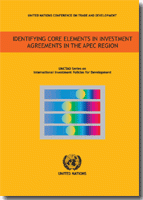
International investment agreements (IIAs) in the Asia-Pacific Economic Cooperation (APEC) forum adopt a range of approaches to addressing the main provisions (the "core elements") of these treaties. This report is based on analysis of a sample of 28 IIAs between and/or involving APEC member economies. These comprise 14 bilateral investment treaties (BITs) and 14 preferential trade and investment agreements (PTIAs).
The report provides a means of considering how different IIAs address three possible objectives: investment liberalization, investment protection, and investment promotion. It explains how APEC economies address the legal issues of international investment, the nature and effect of the core elements that appear in IIAs, and how they interact together. It also identifies the purpose of these provisions and where APEC member countries take common and different approaches. Finally, it compares the approaches taken in "APEC IIAs" with three key "APEC investment instruments": the Non-Binding Investment Principles (NBIP), the Menu of Options, and the Transparency Standards on Investment.
The report underscores three challenges facing APEC - and indeed all - IIAs.
- The first is the need for policy coherence in the form of a consistent approach to domestic economic and development policy.
- The second is the need to balance the interests of investors with the broader public interest.
- And the third challenge is how best to adequately address the development dimension of IIAs and development issues most relevant to developing countries in IIAs. The APEC investment instruments are useful policy tools for working to understand these three challenges in APEC IIAs and for encouraging approaches to negotiating investment treaties amongst APEC member economies - and within the broader IIA system - that seek to address these challenges.


